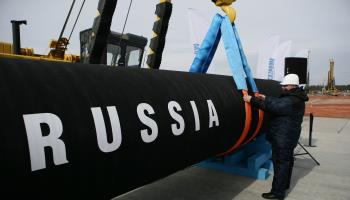The possibility of a ceasefire in Ukraine has raised the prospect of the EU buying more Russian gas
EU officials last month reportedly explored a resumption of large-scale imports of Russian gas, if US-Russia talks end the Ukraine conflict. Russian exports have fallen by two-thirds since 2021 and one only of four pipeline routes is now operational, though imports of liquefied natural gas (LNG) have risen. Some European customers favour Russian gas, which was cheap and plentiful before the 2022 invasion.
What’s next
Subsidiary Impacts
- Ukraine will oppose any increase in European imports of Russian gas.
- The longer Russian gas imports to Europe remain low, the less likely they will increase due to the energy transition.
- Any return of Russian gas would result in lower gas imports from the United States and other LNG suppliers.
Analysis
In 2021, Russia exported over 150 billion cubic metres (bcm) of gas to European markets via four major pipeline routes: through Ukraine, Poland (Yamal-Europe), the bed of the Baltic Sea (Nord Stream) and via the Black Sea and Turkey (TurkStream).
From energy empire to pipeline pariah
By 2024, these volumes had plummeted to just 30bcm, more than 80% below pre-war levels (see RUSSIA: Gas industry outlook will remain bleak – January 29, 2025). The decline followed the invasion of Ukraine, the sabotage of Nord Stream and a host of political and logistical disputes.
Of the 30bcm that did reach Europe in 2024, around 55% flowed through TurkStream, a subsea pipeline that has proven resilient amidst the turmoil of war and sanctions.

The remainder crossed Ukrainian territory under a contract between Gazprom and Ukraine’s transmission operator. However, that deal expired on December 31, 2024 (see RUSSIA: Gas exports to EU will continue – January 2, 2025). Kyiv stood firm and refused to renew it.
In 2025, therefore, only TurkStream remains, likely delivering 15bcm-17bcm — barely 10% of 2021 levels.
The LNG loophole
As pipeline gas imports waned, Russian LNG quietly surged. In 2024, some 24bcm of Russian LNG reached European ports, surpassing pipeline deliveries (see RUSSIA: LNG exports will face more challenges in 2025 – January 28, 2025). Only a sliver (perhaps 3bcm) was trans-shipped for onward sale to Asia. The rest was consumed in Europe.
Russian LNG exports to the EU reached record levels in 2024
This divergence — rhetorical condemnation of Russian fossil fuels, coupled with continued purchases — has left EU policymakers vulnerable to accusations of hypocrisy. As of March 2025, the EU has tightened restrictions, banning trans-shipment of LNG in its ports. Yet there remains no outright ban on imports for domestic use. That, however, could change.
A US-brokered ceasefire in Ukraine, if perceived by Kyiv and its European allies as too lenient, might prompt Brussels to maintain or tighten sanctions. A complete embargo on Russian LNG would be the logical next step. Several member states support it, seeing it as a way to close a political and moral loophole.
However, a full ban would incur costs. Russian LNG met nearly 5% of EU gas demand in 2024. With global LNG markets tight — Asia and Europe already compete fiercely for cargoes — losing 20bcm would drive up prices and complicate storage replenishment ahead of winter. Crucially, the Kremlin’s budget would scarcely feel the loss: LNG exports are exempt from export taxes that apply to pipeline gas.
Arctic opportunities and American interests
Paradoxically, a ceasefire might also unlock new Russian LNG supplies. So far, sanctions imposed by Washington on Novatek’s Arctic LNG-2 project have rendered it commercially impotent (see RUSSIA: Moscow’s LNG plans disrupted by sanctions – September 23, 2024). Though eight tankers have been loaded since late 2023, none have reached the market due to restrictions on ship movements, trans-shipment, and trading.
If these sanctions were lifted, LNG from Train 1 of the project — capable of producing 6.6 million tonnes annually (around 9bcm) — could begin flowing immediately. Train 2, scheduled for 2026, could double output. Train 3 and other Russian LNG schemes, including Baltic LNG and Murmansk LNG, could also advance if longer-standing technical sanctions were eased.
100 million tonnes
Russia’s target for LNG exports by the early 2030s
In theory, Russia could aspire to 100 million tonnes (136bcm) of LNG capacity by the early 2030s, up from around 35 million tonnes today. However, whether the global market would require such volumes is less clear. The United States, Qatar, Africa, and Canada are all racing to bring new capacity online.
Pipelines: ghosts of gas past
Unlike LNG, pipeline gas has never been directly sanctioned by the EU. Yet flows have dwindled. This was due not to policy or sanctions but to practical and political friction: Russian demands for ruble payments, contract disputes, sabotage and the end-2024 closure of Ukraine’s transit corridor.
Although these flows could rebound in a post-ceasefire climate, each route presents practical obstacles.
Nord Stream
Once a key component of Gazprom’s westward exports, NordStream is crippled. The explosion in 2022 damaged both lines of Nord Stream 1 and one of Nord Stream 2. Although one NS2 line remains intact, it has never been certified for use. Approval by the German regulator would be politically incendiary and likely challenged under EU law by countries such as Poland.
Yamal-Europe
Mutual sanctions and frosty relations between Warsaw and Moscow make resumption of the pipeline that runs from Russia to Germany via Belarus and Poland improbable. Poland is using the line in reverse, importing gas from Germany and LNG terminals.
The Ukrainian corridor
This was once Europe’s gas artery with a nameplate capacity of 140bcm. Although Kyiv says it will not sign a new deal with Gazprom, it has left open the possibility of transporting gas sold by third parties. Although political risks abound, this creates a theoretical opening for traders to buy gas at the Russian border and sell it downstream.
TurkStream
Opened only in 2020, TurkStream has operated without interruption. With a total capacity of 31.5bcm, half of which is earmarked for European delivery, it is currently running near maximum. February 2025 flows suggest that capacity has been reached, limiting the scope for further growth.
Buyers in waiting?
Assuming additional Russian gas can physically reach Europe, it is unclear who would buy it.
In the past, low-cost Russian gas was irresistible to European firms. But the war has changed the calculus. Several utilities have severed long-term contracts with Gazprom; others are embroiled in arbitration over undelivered gas (see RUSSIA: Arbitration ruling will shape future of gas – July 23, 2024). Legal clarity will be needed before contracts can resume.
Even so, some contracts remain — mainly with buyers in south-east and central Europe. These total around 16bcm, closely matching current TurkStream flows. Hungary and Slovakia, affected by the end of Ukrainian transit, have already switched to Turkish deliveries. Austria’s OMV, however, has paused its contract.
Should flows resume, other regional buyers could emerge. Croatia, the Czech Republic, Slovenia and Bulgaria might account for another 14bcm. The addition of Austria would raise the total to 20bcm. While far below historical highs, this volume could be politically palatable and would be commercially significant.
Any such trade would likely eschew long-term contracts in favour of short-term, flexible deals, possibly brokered by trading houses. This arrangement would offer discretion to both sellers and buyers — and a buffer against diplomatic fallout.

A worker stands by a pipe during a ceremony to mark the beginning of the construction of Nord Stream offshore pipeline in 2010 in Vyborg, Russia (Sasha Mordovets/Getty Images)
Analyst

Richard Connolly
Senior Analyst,
Russia/CIS

